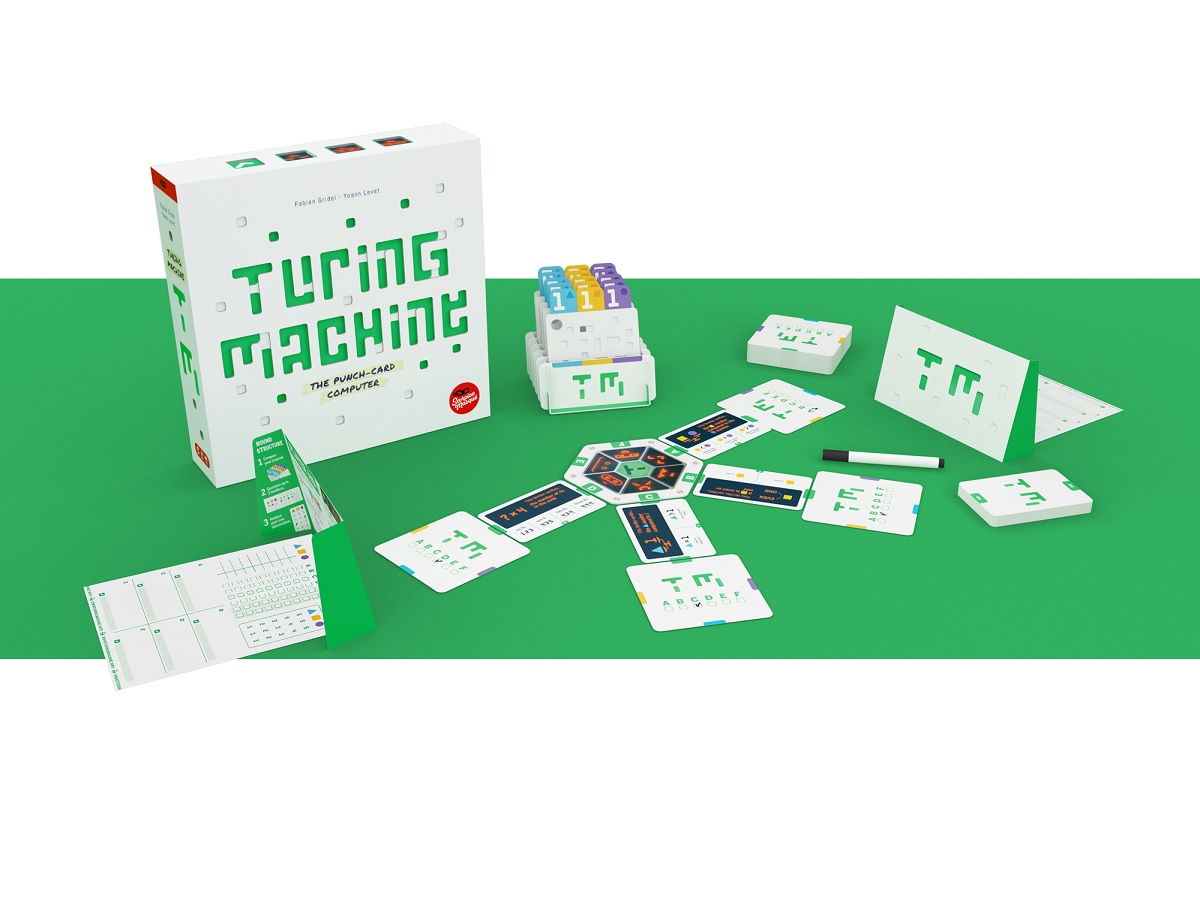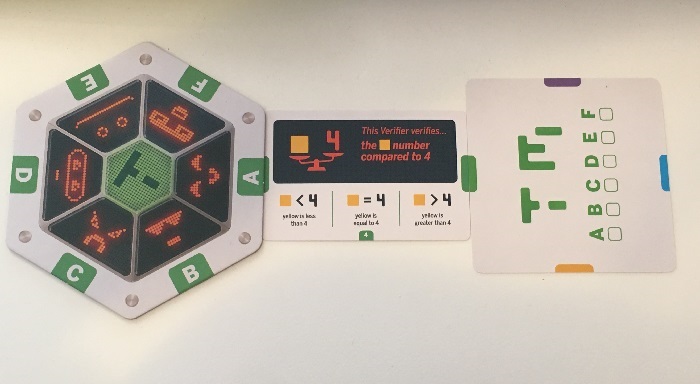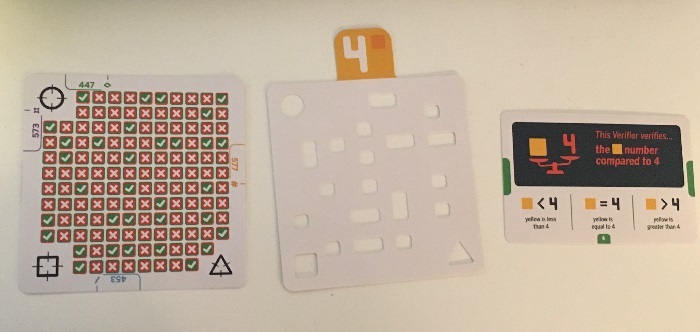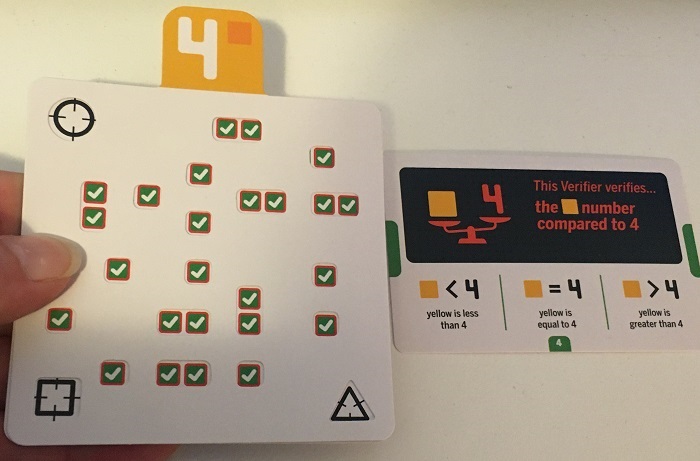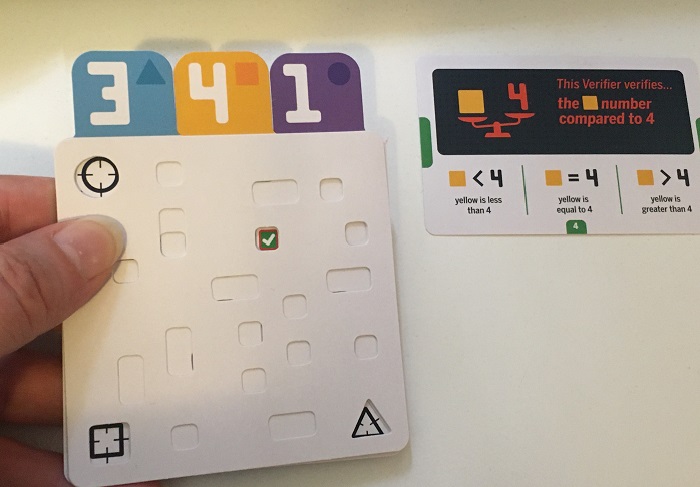Turing Machine may be the best deduction game ever created. It features logical problem-solving with an almost never-ending supply of puzzles and the added touch of nostalgia from good ol’ fashioned punch-cards. Because we all know, nostalgia sells. And it sure did sell! There were no copies left at PAX Aus 2022, and I hear it was the same at the recent PAX Unplugged. Let’s have a look at what makes Turing Machine so gosh-darn good.
What Is Turing Machine?
Turing Machine is a competitive deduction game featuring the basic algorithms of a computer. The goal is to find the three (3) digit numerical code that matches the puzzle. The only clues you have are a bunch of possible rules that apply to this puzzle. Your job is to test the rules against your idea for the solution and narrow down the field of possibilities.
In each round, players simultaneously test a possible solution against the parameters of the puzzle. Each test resolves a question and guides them to which rules are true and which are false. The tests use punchcards, adding to the “analog computer” vibe of the game.
What’s in the Box?
There’s a little set-up required to play Turing Machine, and it almost packs away perfectly into the box. Almost. More on this in a minute.
- 1x Machine Tile – called “The Verifier.” It represents a form of AI and is NOT a player.
- 4x Player Aids
- 1x Dry-erase Marker
- 50x Player Note Sheets
- 1x Punch Card Support
- 45x Punch cards
- 3x sets of 15 cards numbered 1 to 5 in three different colors
- 1x Instruction Manual (with Puzzles #1 – #20)
- 48x Criteria Cars
- 95x Verification Cards
The Instruction Manual contains 20 problems, ranging from easy to difficult. However, there are also millions of problems available on the official website, turingmachine.info—including a daily challenge, which I think I love more than Wordle.
How to Play Turing Machine
We found the rules difficult to explain but fairly easy to pick up once you understand the core concept. The trickiest part was some of the terminology, especially for a family filled with scientists. The following outline is for a general competitive game with two or more players. Turing Machine can also be played co-operatively or solo, as explained further below.
Start by choosing one of the problems provided in the Instruction Manual. For the sake of ease, I’m going to use Problem #01 as our example. Each problem has a set of Criteria Cards showing potential rules to help you solve the problem. Your task is to test the rules and determine which is true and which is false. The Criteria Cards sit next to the corresponding letters on the Verifier, creating the Analog Computer that helps solve your puzzle.
Now for the punchcards. Your goal is to correctly guess the three (3) digit code, with each digit ranging from one (1) to five (5). The punch cards are divided into three (3) shapes, indicating first, second, or third position—triangle, square, or circle, respectively. To begin a round, each player makes a code using the punchcards. You then test this “hypothesis” against one of the Criteria Cards by lining it up against the Verification Card. When you line up all four (4) cards, they should reveal a single window with either a tick/check or a cross.
The criteria rules are not specific, which leads to deductive reasoning. If a tick/check is revealed, your code meets the corresponding rule. It does not mean your digit is the actual answer, merely that it satisfies the criteria in question. Each player can test their potential code up to three (3) times per round. At the end of the round, all players indicate whether they have the solution with a thumbs-up/thumbs-down. If you guess it correctly, you win. If not, you sit out until the end. If there’s a tie, the winner is whoever used the least amount of “tests” against Verification Cards.
What’s Great About Turing Machine
I love Turing Machine, and it has been an absolute hit with the kids. However, I did notice a couple of factors that made it easier for some players than others.
First up: take a look at the notepad. This is the kind of game where your notes will help you. A LOT. The grid on the left is to keep track of each code you are testing. The table on the right notes which numbers you can cross out or include in your final guess. But most importantly, the bottom area is for noting down each criterion you are testing as it relates to its Letter-Position on the Verifier. The first time I played, I didn’t appreciate exactly how helpful this can be. It was not about helping me win; it was about simplifying the ideas in my head!

This leads to my next point: Turing Machine is a multiplayer game, but your deductive reasoning does not depend on other people. Some deduction games rely on how well you can read and play against other players, such as Antidote or One Night Werewolf. Turing Machine has less PvP interaction. The only real interaction is the race to solve the puzzle before anyone else. And to be fair, I think this made Turing Machine a little more enjoyable to play as a family.
Trust Me; I’m a Computer
There is a certain element of trust required to play this game. Like in real life, you need to trust the computer or (in this case) the hours of calculating and developing the punchcards. I played this game with my family, and then I played it with a few IT friends. At one point, we thought we had found an error in the punchcards, which resulted in a very scientific analysis of how that could happen. The truth is it didn’t. In fact, it would be very difficult to have any errors with this game because it is procedural math. It might look like magic, but it is all math.
The issue comes down to the core element of the game. It’s important to remember the goal is to determine which of the Criteria Rules is true. THEN you can use the Criteria Rules to determine the 3-digit code. Each time you test your hypothesis, the Verifier is not telling you that your number is correct. It is telling you that your criteria test is correct. In very rare cases, you may find a number that satisfies two criteria rules (I’m looking at you, Puzzle #19), which can be misleading during your deduction. And while the overall solution is absolutely sound, the process may be confusing if you focus on the number rather than the criteria first.
Final point: Turing Machine can also be played solo, and I strongly recommend giving it a try. Our 13-year-old son really wanted to work on his deduction skills, but he doesn’t enjoy the manipulative element his older brother often brings to the game. Turing Machine has worked out to be the perfect match for him. He can play the game solo when he wants, using puzzles generated off the website so that it doesn’t interfere with family game time using the puzzles in the instruction book. He can also do the Daily Puzzle and compare with the rest of the family.
Is Turing Machine Suitable for Gameschooling?
This has now become the most popular question I am asked by gamer-parents.
Turing Machine is a brilliant game for procedural math, deductive reasoning, and logic processing. The Criteria Rules are an excellent tool for breaking down the steps in the process. Everything about this game is math. However, if you are using this game for gameschooling, Turing Machine does not fit into the basic or core math syllabus. It would fit better with more advanced math concepts or perhaps more direct IT subjects.
Turing Machine has a lot to offer on Family Game Night. Thanks to its simultaneous gameplay, it offers a great balance between competition and self-satisfaction. The puzzles are clever and rewarding, while the presentation is sweet enough to make the nostalgia appealing and not dated. Best of all, Turing Machine is ready to play in any mood, be it solo or with others. I stand by my opening statement: Turing Machine may be the best deductive game created. It is most certainly top of my list.
Turing Machine is available now (released November 29, 2022). It is designed for 1-4 players (but you can sneak in an extra player or two if everyone behaves themselves with the punchcards). The average playtime is about 20 minutes. For more details, check out the official website or ask at your local games store.
Score: 4.5 out of 5 Perfect Punchcards
